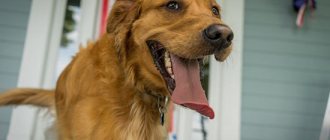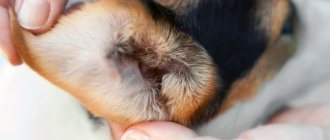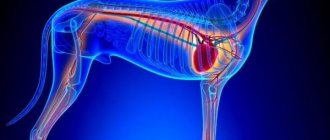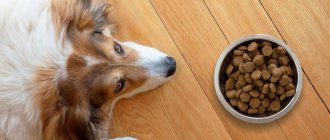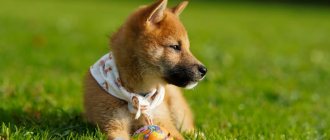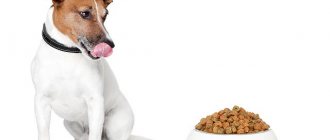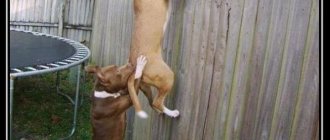Save the article:
You let the dog out for a walk, and he goes straight to the green grass and selflessly eats it? Yes, this happens very often. Some doubt the benefits of such an “event,” while others advocate the necessity and naturalness of the process of eating grass. It turns out really interesting: the grass does not bring vitamins to the body, since it comes out undigested, but the dog eats the grass anyway - let's figure out why they do this and what the consequences may be.
Why does a dog eat grass, what could be the reason for this behavior?
Most pet owners think they know the answer to this question. With the help of greens, pets are treated, get rid of unpleasant odor from the mouth or replenish vitamin deficiencies.
The theories are good, but do not provide evidence. Dogs do not think about the “ambergris” from their mouths, and vitamins do not come with the grass, or rather, they are not absorbed by the body, it comes out undigested. But the dog eats grass, what is the reason then?
- The need to cleanse the intestines. If the pet receives too much food, its meals are frequent or the diet is unbalanced, it begins to experience discomfort and heaviness in the stomach. “Bad” sensations are caused by swallowed small parts of toys and clothes. Hard blades of grass irritate the mucous membrane, provoking a gag reflex.
- Frequently eating grass may indicate an excess of meat in the diet. It is difficult for the stomach to digest large amounts of protein foods. The fiber contained in the blades of grass improves peristalsis and speeds up the process of emptying the rectum.
- Playfulness. At a young age, puppies learn about the world, including through their taste buds, so when playing outside they may “taste” the lawn out of interest. The kids will be playful and active, and you will easily recognize specific behavior.
- Taste preferences. Some dogs like the taste of certain plants.
- Pathologies of the digestive system. Many of them cause discomfort, heaviness in the stomach, which the animal tries to get rid of. In case of illness, you will see other alarming symptoms: loss of appetite, weight loss, lethargy, apathy, upset stool.
Most often, a dog cleanses its stomach with wheat grass (the cereal family), it irritates the intestines, promotes the outflow of bile, and is safe for the animal. At home, pets may gravitate towards tops of root vegetables, parsley, and lettuce.
Why would a dog be made to vomit?
Eating grass does not always result in vomiting, but it can sometimes happen, especially in dogs that rarely eat this way. There is an assumption that this is a way to induce vomiting when feeling unwell.
How to detect if your dog is feeling unwell? For example, you may notice that your pet is panting a little before going outside, or that after the dog has eaten something that should not be eaten. The feces may also be a little runny, discolored, or different than usual, and the dog may appear a little depressed or less energetic than usual. Most of these symptoms may be a sign of indigestion.
Therefore, once outside, the dog may begin to swallow handfuls of grass. Long, tickling blades of grass can help regurgitate the cause of indigestion.
Does this phenomenon pose a danger to the health of the animal?
Eating greens is a normal process for dogs and does not need to be prohibited. Animals instinctively know what suits them. Potential risks can be prevented:
- Avoid flower beds, fenced areas in parks and squares, where chemicals are often used.
- Do not let your pet into the thickets of grass, there are a lot of snails and slugs from which they become infected with helminths. There is also a high chance of catching ticks or getting injured.
Dangerous plants
Not only wild grasses and shrubs can be dangerous and poisonous. Some house flowers contain toxins that can lead to poisoning. At best, the dog will begin to vomit for a short time; at worst, the pet may die.
Dangerous plants:
- Crassula;
- belladonna;
- henbane;
- wolfberry;
- horsetail;
- hogweed;
- oleander;
- dieffenbachia;
- spotted hemlock;
- common datura.
Typically, adult animals avoid such crops on an instinctive level, but sometimes curious or young dogs bite off and swallow poisonous plants.
What types of grass can a dog eat safely?
We found out that it is not scary for a dog to eat grass. However, not all types are safe. The first thing you need to make sure is that the lawn has not been treated with fertilizers. Second, it must be located away from roads and highways, otherwise heavy metals will accumulate in it. The benefits will be:
- wheatgrass;
- sprouted wheat, oats and rye;
- calendula, chamomile;
- beet and carrot tops;
- greens (parsley, dill, mint);
- sow
The list of which herbs dogs should not eat is huge. In many plants, only the leaves, inflorescences or roots are poisonous. For example, chrysanthemums or azaleas that grow in garden beds can be harmful. But animals instinctively sense danger. You should prohibit them from eating greens if:
- you know that lawns have been treated with chemicals;
- you have recently been given an anthelmintic;
- There have been cases of “dog exterminators” in your area.
Expert opinion
Kuzmenko Olga Olegovna
Information about the expert
Ask a Question
In the city, there are other pets walking on lawns from which you can become infected with parasites. Regularly prevent helminths with anthelmintic drugs.
The grass is delicious!
You can be sure that some dogs simply love the taste and texture of grass. Many people also suggest that eating grass can provide your dog with fiber and vitamins that are not enough in regular food.
Most modern domestic dogs have a fairly limited diet, while its “wild” relatives eat exclusively natural foods that grow or run on the ground. Coyotes, for example, are carnivores that feed on smaller animals. In fact, many wild dogs also eat roots, herbs, and berries in addition to meat.
This tendency to eat plants also shows up in your dog's behavior. In addition to grass, it's likely that your pup will occasionally enjoy a variety of raw plant "snacks" such as sliced bananas, green beans, strawberries, or even apple slices. You may also find that if your dog is turned off by raw vegetables, he will happily enjoy them cooked.
When should you contact a veterinarian?
If a dog eats grass outside and then vomits white foam, this is normal. In 20% of cases, the body cleanses itself using the gag reflex, in the rest - by defecation, often loose stool. There are situations when you need to consult a doctor in time:
- Severe stomach upset, symptoms of dehydration.
- Repeated vomiting (lasts more than a day).
- Refusal to eat, lethargy and apathy.
- Heat.
- Bloating.
Emergency assistance is necessary for loss of consciousness, bloody vomiting, and convulsions. These symptoms may indicate poisoning or serious pathologies.
Owners need to take into account the fact that dogs are allergic to grass. It occurs not only when ingested, but also when walking. The eyes turn red, the animal itches, scratches its face, and sneezes. In this case, you need to contact a veterinarian, identify the allergen, walk on paved roads, and buy only specialized grass for your pet in stores.
What to do if your dog is poisoned by poisonous grass
Unfortunately, some pet dogs have lost the ability to recognize “safe” grass and sometimes cannot distinguish between poisonous plants and beneficial ones. Therefore, owners need to carefully monitor what their four-legged friend eats. If the animal eats poisonous plants, it is necessary to provide immediate assistance and take it to a veterinary clinic.
First of all, you need to cleanse your stomach . To do this, the dog is forced to drink a saline solution and given activated carbon or another suitable sorbent. This must be done immediately, as some poisons act very quickly, and the dog may not survive until the veterinarian arrives.
First aid:
- The dog is fixed in a sitting position. One person should hold the pet in a sitting position, and the other should pour in a saline solution (1 tbsp/l of salt per 1 liter of warm boiled water).
- For rinsing, a large syringe from 20 to 50 ml without a needle or a bulb with a straw is suitable. A small dog needs approximately 20-40 ml of saline solution.
- The liquid is poured in from the side. To do this, insert a tube or the nozzle of a syringe into the space between the molars and slowly pour out the liquid. The dog's head should be raised up during the procedure.
- If the pet does not take a sip, then it is stroked on the throat. Gentle stroking will cause a reflexive gulp. After this, the muzzle is lowered and waited for about 10–15 minutes .
- If vomiting does not appear, then the procedure is repeated 2-3 times with a short interval. Simultaneously with the introduction of liquid, it is necessary to massage the stomach.
- After the animal vomits, it is soldered with activated carbon or another absorbent.
If the dog feels well, and particles of the plant came out along with the vomit, then you do not need to consult a doctor. But if your pet develops alarming symptoms, then you need to take the dog to the veterinarian immediately after washing the stomach.
When to contact a veterinarian
In case of severe poisoning, the dog may die from intoxication, so try to treat the pet yourself. You need to contact the clinic when the first symptoms of intoxication or poisoning appear.
Alarming symptoms:
- refusal of food and water;
- thirst;
- apathy, lethargy, loss of activity;
- rapid breathing and heart rate;
- increased body temperature;
- cramps, muscle tremors;
- dilated pupil;
- cyanosis, anemia, hyperemia of the skin and mucous membranes;
- repeated vomiting or diarrhea;
- blood in vomit, urine or stool.
All of the above symptoms may be signs of poisoning or a dangerous infectious disease. In any case, you should urgently seek help from a veterinarian.
What can replace grass for your pet?
If a dog asks to eat grass, what can you replace it with to keep your pet safe? First of all, think about why your pet needs greenery:
- Check his health and the functioning of his gastrointestinal tract.
- Analyze your diet. The wrong approach to nutrition causes heaviness, make meals more frequent and portions small.
- Add vegetables and fruits to the menu. Check your grain to meat ratio.
Pay attention to the intake of the required amount of vitamins and minerals. There are enough of them in professional feeds; for natural nutrition, it is recommended to use complex additives. If you take the right measures, your dog will stop constantly needing greens.
You can also plant grass for dogs at home. The “correct” seeds are sold in pet stores, most often these are oats and wheat. They are inexpensive, and with regular watering they will not dry out within 3-4 weeks.
Allow or not
Even if you are sure that your dog eats properly and gets everything it needs from food, in my opinion, it is okay to allow your dog to “pinch” the grass. Of course, greens should not be allowed to be consumed as a substitute for the main meal. But nothing bad will happen from a few blades of grass eaten with pleasure. Moreover, many dogs get great pleasure from the taste and smell of this or that herb. It happens that our Jack likes to “get caught” in a clearing and pick another blade of grass. But he does this extremely rarely. Maybe because he already gets enough vegetables and fresh herbs.
How to protect your pet from the consequences of eating greens on the street?
Artificial grass for dogs is a great option to keep your pet safe. You can grow it at home or in your summer cottage. In the first case, you will need seeds from a store or street (they are easy to collect if you know what the right one looks like). At home, you only need to make sure that the dog does not drop the potty or play with the soil. It is better to give this grass to young puppies under supervision. In a suburban area, plant “greens” away from flower beds and beds so as not to accidentally water them with fertilizer.
If you don’t have a summer house, and you haven’t yet had time to sprout your oats or wheat, pick “good” grass on the street (far from the road), bring it home and wash it. It will be safer than eating lawn outdoors.
We found out what grass dogs eat and why they do it. If the behavior is irregular and there are no warning signs, do not worry and follow safety measures.
Feeding recommendations
Any grass growing outside - in a square or park, on a city lawn or in a forest - is a potential source of danger. Therefore, veterinarians give their recommendations: how to protect your pet from diseases.
Urban public areas (parks and street lawns, courtyards) can be treated with pesticides, so it is better to choose wild fields and forests for walks.
You should not allow your pet to eat grass near roads: plants have the ability to accumulate heavy metals and are therefore undesirable for the animal.
It's okay if your dog eats soft, juicy grass, but make sure that he doesn't chew too hard stems, which can damage the walls of the stomach and esophagus.
After eating grass, the animal may vomit. Veterinarians believe that this is a natural process, since the animal’s body is not able to digest it. If vomiting is not severe, there is no reason to worry, but hard blades of grass and plant stems can injure the gastric mucosa and mix with hair in the intestines, resulting in the formation of lumps. They usually leave the body with vomiting, but in some cases they can cause intestinal obstruction.
Important!
If there is prolonged indomitable vomiting or the presence of blood in the vomit, you should take the dog to a veterinary clinic as soon as possible.
How much to give?
No one gives specific instructions about the quantity. Veterinarians recommend allowing the dog to decide how much it needs to eat. But if the animal cannot eat it directly, you need to consult a doctor. Usually dogs just pinch it and do not eat it as food. A small pot of grass lasts them at least an early spring month or two. Although this also depends on the size of the pet.
In order not to think about quantities, it is easier to put a pot of grass in a place accessible to your pet, where he can get it at any time. On the street, you don’t need to distract the dog by dragging it by the leash; it will nip a little and move on on its own.
Good to know
- What types of breathing problems are there in dogs?
- Why does my dog often vomit yellow or white foam? Treatment for vomiting in dogs
- Why doesn't the dog eat anything? The dog doesn't eat?
- Why does a dog scratch its ears and shake its head? Why does my dog constantly shake his ears?
- What is the reason why a dog constantly whines?
- Why is my dog breathing heavily and frequently?
- Why does a dog eat cat feces?
- Why does a dog drink a lot of water?
- Eye discharge in dogs
- Why does a young dog have bad breath?
- Why can a dog lose hair in patches?
- Why does my dog have diarrhea? Dog diarrhea
- How to treat bartonellosis in dogs
- Bordetelosis and Bordetella in dogs
- How to treat adenovirus in dogs?
- Why is the dog lethargic and constantly lying down?
Grazing
The first reason why dogs may eat grass is for grazing, where your dog will happily munch on the grass without experiencing any ill effects. Every dog has its own unique traits, but it's not uncommon for this behavior to occur when your pet is anxious or even a little bored.
Some veterinarians suggest that dogs eat grass to fill nutritional deficiencies, but even dogs who eat a balanced diet will eat grass. Perhaps they just like the taste. So even if you feed your dog well, they may still want some fiber or greens!
Causes
One common myth is that your pet eats grass because it contains essential vitamins. But this is not so, the gastrointestinal tract of such animals does not have enzymes capable of breaking down and digesting the greens that have entered it, which means that the necessary nutrients are simply not absorbed by the body.
So, based on research on this topic, several reasons can be identified.
Discomfort, bloating
. Sedge, wheatgrass, bluegrass and other plants have stiff bristles, so if your dog eats grass and vomits once or twice, this is normal. This is how animals try to get rid of excess bile and unprocessed food. But not all dogs have this reaction. Many pets can safely eat herbs without vomiting.
The grass contains a lot of fiber and moisture; when it enters the intestines, these substances help to liquefy stool, making it easier for your pet to go to the toilet.
Many experts believe that another reason for eating grass is that the dog simply likes greenery.
. Therefore, some pets choose garden herbs, young nettles, beet leaves, carrots, lettuces, cornflowers and calendula flowers. Puppies and young pets are especially keen on this. Such herbs are “soft” and therefore do not contribute much to cleaning.


